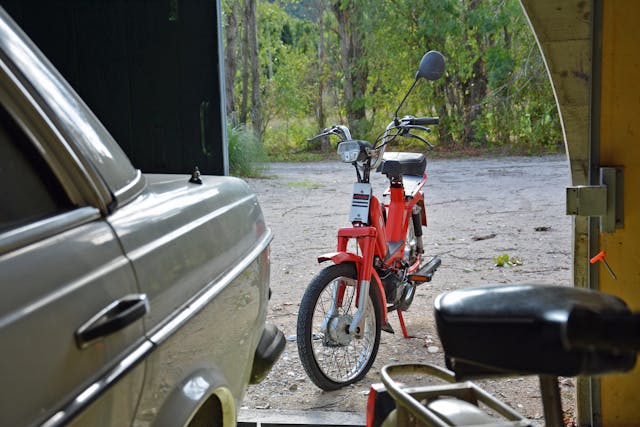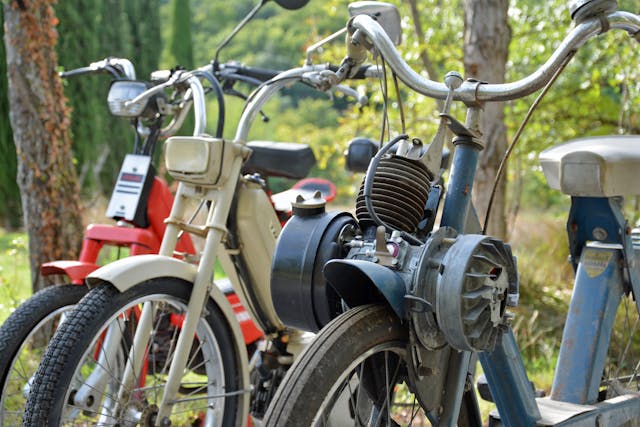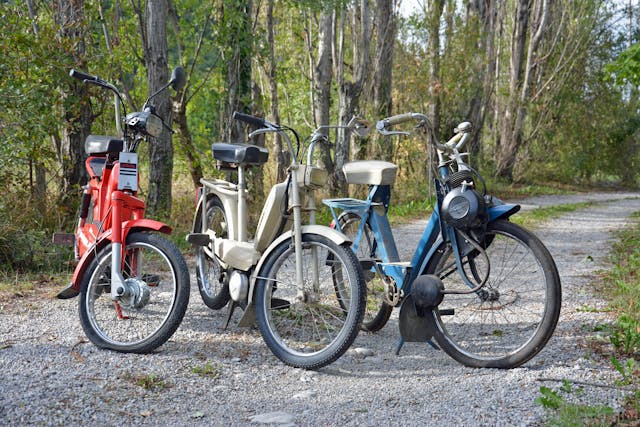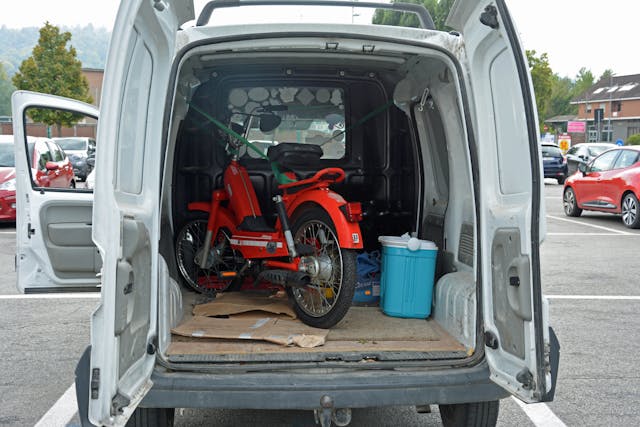A vintage moped could be your perfect winter project
Dozens of hairpins dot the road that links Italy to France, via the Montgenèvre mountain pass. Every time I leaned my van into one, the faint smell of gasoline and oil permeated the cabin. I wasn’t worried, though. There was no risk of fire or engine failure, because the scent came from the back of my van, not from under the hood. The issue stemmed from what the seller of an Atala Uno referred to as una perdita di benzina. In English, a fuel leak.
It would have been sacrilege for me to drive to Italy, where herds of 100-euro mopeds freely graze local routes, without lassoing one and hauling it home to France. While that’s easier said than done if you live in, say, Ohio, mopeds were relatively popular in America in the 1970s. You don’t necessarily need to hop over the pond to get hooked on them. And if you’re craving a low-stress winter project, look no further: they’re cheap, easy to work on, and just as charming as a vintage car while taking up far less space in your garage.

User-friendly is the name of the moped game
The moped is among the simplest and most basic form of motorized transportation ever developed. It’s one of those “hold my beer and watch this” inventions created by tinkerers who complained that pedaling a bicycle was too exhausting and that operating a motorcycle was too expensive.
Most older models are powered by an air-cooled, two-stroke one-cylinder engine whose displacement falls just under 50 cc, which represents about three cubic inches—a rounding error in Hemi-speak. Approximately the size of a medium-duty chainsaw engine, the little mill almost always spins the rear wheel via a chain. Some mopeds are equipped with a rudimentary suspension, and nearly all use cable-operated brakes on both wheels. Most have a pair of pedals, too, which are used to start the engine and to supplement it when riding up a steep hill.
Simplicity brings several major advantages. Assuming the compression is good, a moped engine only requires two-stroke fuel and spark to start and run for hours on end. There is no starter motor, no battery, no water-based cooling system, very little wiring, and, of course, no electronics to mess with. Some versions even ditch the fuel pump and rely on gravity to feed the carburetor, and none ever require an oil change. Unless you’re fully rebuilding the engine, special tools are largely limited to a flywheel puller and a holding pin to prevent the engine from turning while you’re working on it. You can change a moped engine in an hour using only the tools provided in a box of IKEA furniture.
Setting the ignition point timing on my Solex 3800 moped requires using a piece of cigarette rolling paper as a gapping tool, according to the manufacturer’s user manual. Normal paper works, too. Nail polish can reseal a fuel pump, though the manual does not specify which color should be applied; I used a shade of dark purple from my wife’s arsenal. Replacing a tire or an inner tube is no different than changing either on a bicycle.

Taking it in
Classic cars are often simple, too; I bet there are some Lego Technic sets made up of more parts than my 1978 Citroën 2CV. However, mopeds stand tall at the top of the winter project pecking order because they’re accessible to a stunningly wide audience. Unless you drive a Smart ForTwo, you don’t need a van or a trailer to move one. I’ve hauled my Solex 3800 in a Ford Fiesta-sized Citroën C3 hatchback with the rear seats folded flat. My Peugeot 101 moped is markedly smaller than a 27.5-inch mountain bike, so it hogs less space in my garage, though it’s far heavier so hanging it from the ceiling or from a wall is out of the question. It’s still light enough to effortlessly push around and lift, however, which is worth a lot when you’re juggling multiple projects with limited garage space.
Instead of braving Siberia-like garage temperatures, bundled up like the Michelin Man and warding off frostbite on your phalanges, you can push your moped inside and wrench on it from the comfort (and heat) of your living room, office, or—why not?—kitchen. It’s wise to put a few thick pieces of cardboard under the engine, but changing a coil, replacing a piston ring, and nearly any task in between can be done indoors.

On the flipside …
One common misconception about mopeds, that merits a clarifying rebuttal, is that they’re dangerous. None of mine have a speedometer, but tapping open a GPS app reveals I’m able to cruise at roughly 20 mph on flat ground, up to 15 mph when going up a hill—flat-out, with the tiny exhaust pipe smoking like it just elected a new pope—and about 25 mph when sailing down it. If you ride a mountain bike, you’ll probably go just as fast. If you ride an e-bike, perhaps even faster. Riding a two-horsepower moped is undeniably more dangerous than sitting on a couch, but it doesn’t require the daredevil spirit of Evel Knievel. Wear a helmet, and it’s as hazardous as biking to the corner store.
Hit-or-miss parts availability is the main drawback to hoarding mopeds. Mechanical components like coils, ignition points, and fuel taps are reasonably easy to find, and there is a surprising degree of interchangeability between various engines, but you’ll be at the mercy of international parts peddlers and barn-digging Craigslist dealers when it comes to finding trim pieces. I suggest buying the most original and most complete example you can find, even if it requires paying a premium, because sourcing a missing fairing or a used seat can become a months-long hunt.

Pacer, Puch, or Honda?
Hugely popular in Europe, two-stroke mopeds were ideally suited to moseying around the post-WWII countryside. Commuters in Los Angeles were not nearly as tempted to buy one, but several models were nonetheless made available in the United States. While their desirability peaked in the 1970s, in the wake of the first oil crisis, they ultimately left small imprint on the American automotive memory. Mopeds simply didn’t make as much sense in a nation where most people can claim a driver’s license and a 31-gallon tank of cheap unleaded on their 16th birthday.
Solex—yes, that Solex—was one of the companies that tried getting American riders hooked on French-built mopeds. Its two-wheelers were extremely unusual because they were powered by a front-mounted engine that, when unlatched and pivoted down, spun the front wheel via a roller. The design requires several miles of riding to master, because the center of gravity is directly in front of you and at knee level. Sometimes marketed as “the bicycle with the tiny motor,” and sold by independent distributors in various states, Solex’s mopeds were optimistically advertised as being capable of hitting 200 miles per gallon. It’s an excellent starter moped. Mine is a 1968 model that’s a running project, hence why it’s partially disassembled.
Motobécane sold the Moby (no relation to the whale or to the singer) in the United States through 1980, and it was the segment’s leader until it left the market, according to the experts at Detroit Moped Works. American Machine and Foundry (AMF), Pacer, Puch, and Honda are among the dozen-plus brands that also distributed mopeds in the United States in the 1970s and the 1980s.
Rummage through the local classifieds, and you’ll have no trouble finding a project. Fully-restored mopeds often trade hands for four-digit sums, but I’ve never spent more than a couple hundred bucks on a ran-when-parked-style fixer-upper, and you shouldn’t, either. Set aside between $100 and $150 for the various parts needed to put it back on the road, like ignition bits and a pair of tires, and you’ll be ready to ride when the temperature goes back up.


